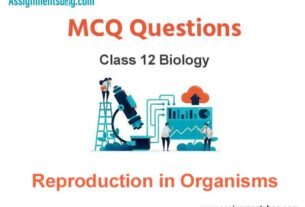Please refer to MCQ Questions Chapter 7 Introduction to Macro Economics Class 12 Economics with answers provided below. These multiple-choice questions have been developed based on the latest NCERT book for class 12 Economics issued for the current academic year. We have provided MCQ Questions for Class 12 Economics for all chapters on our website. Students should learn the objective based questions for Chapter 7 Introduction to Macro Economics in Class 12 Economics provided below to get more marks in exams.
Chapter 7 Introduction to Macro Economics MCQ Questions
Please refer to the following Chapter 7 Introduction to Macro Economics MCQ Questions Class 12 Economics with solutions for all important topics in the chapter.
MCQ Questions Answers for Chapter 7 Introduction to Macro Economics Class 12 Economics
Question. Study of macroeconomics is concerned with:
(a) theory of demand
(b) determination of aggregate output
(c) general price level
(d) both (b) and (c)
Answer
D
Question. In the classical view, the price level is determined by
(a) aggregate supply
(b) aggregate demand and supply
(c) supply of money
(d) aggregate demand
Answer
C
Question. Partial equilibrium relates to:
(a) microeconomics
(b) macroeconomics
(c) both (a) and (b)
(d) none of these
Answer
A
Question. Which of the following is not a macro variable?
(a) Wholesale price index
(b) Output of the firm
(c) Aggregate demand
(d) Aggregate supply
Answer
B
Question. Under Keynesian model aggregate expenditure is measures along
(a) Vertical axis
(b) Horizontal axis
(c) Vertical intercept
(d) 450 line
Answer
A
Question. Broker’s commission on sale and purchase of second hand goods is included in national income because:
(a) It is a part of compensation of employees
(b) It is a part of GRoss Domestic Capital Formation
(c) it is an income earned for rendering productive services
(d) None of these
Answer
C
Question. Economy may be classified as:
(a) Capitalist
(b) Socialist
(c) Mixed
(d) All of these
Answer
D
Question. Mr. Skund Kumar wants to study the national income. Which branch of economics will he have to study?
(a) Microeconomics
(b) Price theory
(c) Factor price determination
(d) Macroeconomics
Answer
D
Question. Macro-static equilibrium implies:
(a) A complete absence of change
(b) A change at an unchanged rate
(c) A change in only absolute values
(d) None of these
Answer
A
Question. The reason for downward shape of production possibility curve is:
(a) Increasing opportunity cost
(b) Decreasing opportunity cost
(c) Same opportunity cost
(d) Negative opportunity cost
Answer
B
Question. The central problem of an economy is:
(a) What to produce ?
(b) How to produce ?
(c) How to distribute produced goods ?
(d) All of these
Answer
D
Question. Interest rates and bond prices are;
(a) positively related
(b) negatively related
(c) not related
(d) Either a or b
Answer
B
Question.“Economics is a science of logi(c)’’ Who said it ?
(a) Hicks
(b) Keynes
(c) Robbins
(d) Marshall
Answer
C
Question. Mr. Skund Kumar wants to study the national income. Which branch of economics will he have to study?
(a) Microeconomics
(b) Price theory
(c) Factor price determination
(d) Macroeconomics
Answer
D
Question. What is known as the study of individual units?
(a) Macroeconomics
(b) Income and Employment Theory
(c) Microeconomics
(d) Development economics
Answer
C
Question. The basic factors of production are land, labour, capital, and _____.
(a) Enterprise
(b) Investment
(c) Machinery
(d) Resources
Answer
A
Question. Multiplayer is the ratio of
(a) change in income to change in investment
(b) change in investment to change in income
(c) change in income to change in interest
(d) None of the above
Answer
A
Question. Which one is inclded in National Income?
(a)winning from lottery
(b) milk purchase by a dairy shop
(c) national debt interest
(d) none of these
Answer
D
Question. LM curve represents the combination of ;
(a) price and out put
(b) Demand for money and supply of money
(c) income and investment
(d) Money supply and nvestment
Answer
B
Question. What is the name of the book written by J.M. Keynes?
(a) The Wealth of Nation
(b) The General Theory of Employment, Interest, and Money
(c) Political Economy
(d) None of these
Answer
B
Question. Under Keynesian theory of income determination, investment
(a) Depends on income
(b) Endogenous
(c) Exogenous
(d) Depends on money supply
Answer
C
Question. A laptop purchased by consumer is an example of
(a) An intermediate good
(b)A consumer good
(c) Intermediate consumption
(d) None of the above
Answer
B
Question. Which of the following is studied under Macro Economics ?
(a) National Income
(b) Full. Employment
(c) Total Production
(d) All of these
Answer
D
Question. which of the following is not an economic activity and hence not included while estimating national income in india?
(a) medical services rendered by a dispensary
(b) a housewife doing household work
(c) a lawyer doing his practice
(d) a maid working full time with a family
Answer
B
Question. Study of aggregates is known as _________
(a) Macroeconomics
(b) Microeconomics
(c) Price theory
(d) Factor price determination
Answer
A

We hope you liked the above provided MCQ Questions Chapter 7 Introduction to Macro Economics Class 12 Economics with solutions. If you have any questions please ask us in the comments box below.


